 Argentinian Aircraft Carrier, ex-HMS Warrior (1958-1971)
Argentinian Aircraft Carrier, ex-HMS Warrior (1958-1971)
Argentina Day ! For this national independence day, let’s see the fleet’s flagship for full decade, the aircraft carrier ARA Independencia, also first of the kind in the Armada de Argentina. This ship was one of the many ex-colossus class aircraft carriers that saw plenty of service under others flags dueing the cold war. She was the ex-HMS Warrior, one of the early Colossus class, seeing service from April 1945 to February 1958, also under Canadian flag. She was modernized before delivery. Due to her small size and lack of modern amenities, she only could operate helicopter, piston-engine models and early jets such as the Panther and Cougar. In 1970 she was placed in reserve. Her replacement was ARA Veinteicinco de Mayo, well modernized and famous for her participation of the Falklands war in 1982. #argentinaday #coldwar #colossusclass #aicraftcarrier #independencia #armada #armadadeargentina
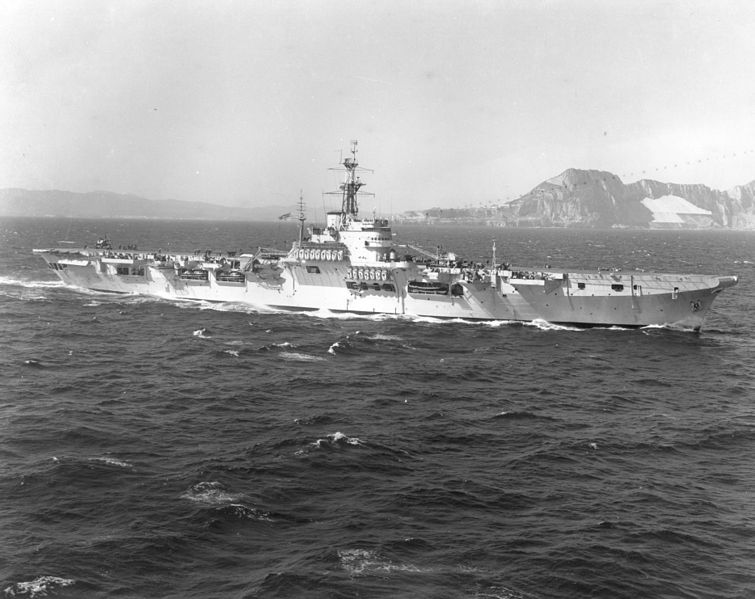
The former HMS Warrior (R31) in the 1950s
Originally the British Royal Navy intended to send the carrier to the Indian Ocean area during World War II. As a measure to save construction time, it was built without heating for the on-board equipment since the heat would not be necessary in the warm waters of said ocean. She was immediately transferred to the Canadian Navy. The lack of heating equipment was fundamental when the ship began to be operated in the east of said country, despite which it was considered fit for service. However, she was included in the negotiations with the British Royal Navy to obtain a new aircraft carrier that was finally HMCS Magnificent (CVL 21).
HMS Warrior was returned to the United Kingdom on March 23, 1948 and took part in Operation Grapple (the first British test of a hydrogen bomb). The ship was later refitted at HMNB Devonport and fitted with a flexible deck coating with rubber layers to test the feasibility of receiving non-undercarriage aircraft of the ‘Sea Vampire’ type which was tested but not entered into service.
Her RN service was fairly short: In September 1949 she in service, but only making pilot qualifications and tests, and she was soon recommissioned as a troop and aircraft transport for the British contingent deployed in Korea by June 1950. In 1952-53 she was at HMNB Devonport and recommissioned (notably radar upgrades, armament changes, modernized island, a bit taller, and new lattice mast). By December 14, 1954, she entered the drydock again for a last modification: Modernized radars, 5° angled deck, insulation for tropical service and partial air conditioning. She was eventually decommissioned and offered for sale,then purchased by the Argentinian Government. This purchase was enabled in part from funds secured by the sale of the battleships Moreno, Rivadvia and Puyrredon.
Design of the Independencia
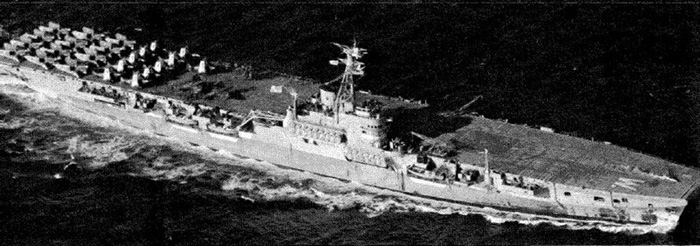
HMS Warrior was a Colossus-class light aircraft carrier, 630 feet (192 m) long between perpendiculars, 695 feet (211.8 m) overall, with a waterline beam of 80 feet (24.4 m) and overall at flight deck level at 112 feet 6 inches (34.3 m). Mean draught was 23 feet 3 inches (7.1 m) based on a standard displacement of 13,350 long tons (13,560 t) as built, 18,300 long tons (18,600 t) fully loaded.
The original carrier was designed to handle 42 aircraft between the hangars and decks, but the cold war new heavier and larger models reduced this to about thirty or less. The initial anti-aircraft defence comprising four twin-mounted and twenty single-mounted 40 mm Bofors guns was of course modernized, with less mounts, but of a more modern pattern and guidance. The original radar installation The Type 79 and Type 281 long-range air search radars were not kept, as the Type 293 but the Type 277 fighter direction radar was, as well as the “YE” aircraft homing beacon. The full crew of 1,300 did not changed much.
Hull and general design
ARA Independencia was very much the same carrier as the original ship. She displaced 13,350 tonnes standard and 18,300 tonnes fully loaded. Her dimensions remained the same apart her width at 192 meters in lenght under perpendiculars and 211.2 metrers overall for a 24.4 meters beam at the waterline, and a mean draught of 7.09 meters deep load. Her flight deck was angled in 1955 and thus now added to her beam overall at deck level.
Armour protection layout
No change from the orignal design as planned in 1942. There were extra arpour plating around aircraft torpedoes warheads rooms, just 10 mm or 0.4 inches thick. She also had longitudinal watertight bulkheads covering the machinery and some reserve of buoyancy. These transverse bulkheads were designed to allow survival even after two complete sections were flooded. The machinery arrangement in echelon compartments, well separated alsp helped the purpose. Fire protection were standard, with fireproof curtains to divided the hangar interior and sprinklers. There seems to be no NBC protection of ship (extra sealing, overpressure, wahrover pumps on deck…).
Powerplant
No change from the original, also wit the two sets of Parsons geared steam turbines completed by four Admiralty 3-drum boilers. This machinery was split into two spaces, each containing two boilers and one turbine. They were separated by 24-foot (7.3 m) spaces which contained aviation fuel and received additional armour. These spaces in addition were placed en echelon to avoid a single torpedo hit causing too much flooding. This powerplant was rated to 40,000 shaft horsepower (30,000 kW). Top speed was about the same, at 25 knots (46 km/h). As for range, she carried 3,196 long tons (3,196 or 3,247 t depending on sources) of fuel oil which ehabled 8,300 nautical miles (15,372 km) at 20 knots (37 km/h) or 12,000 nm at 14 kts cruise speed.
Power, h. p.
Armament
3d model on artstation src
It was reduced but improved in quality, although essentially “WW2 legacy” type. No missiles. Idependencia had a quadruple 40mm/60 Mk 2 bank and nine twin 40mm/60 Mk 1 mounts with a better targeting system. However it seems to change. In 1960 she seemingly had only five twin mounts, one at the foot of the island forward, and four in individual sponsons fore and aft. In 1968 she seemingly had twelve mounts, with the larger sponsons fore and aft being occupied by two mounts each, of the same model.
Her final air group as delivered was set at only 22 aircraft, practically only F4U Corsair fighters.
Sensors
Type 277 fighter direction radar
Still dependable this 4.5 ft (1.4 m),500 kw “bowl-like” antenna is a 1943 design. it was used for Sea-surface search, early warning. Specs:
Frequency: 2950 ±50 MHz (S-band)
PRF: 500 Hz, beamwidth 6.2º, pulsewidth: 1.8 or 0.7 µs
RPM: 0 to 16 rpm
Range: 1 to 11 NM (1.9–20.4 km)
Azimuth 360º precision ~2º, 250 yards range
Type 279
A veteran early warning radar designed in 1940. Powered by 70 Kw, it worked at a Frequency of 43 MHz with a PRF of 50 per second, Pulsewidth 7–30 μs, 50 nautical miles (93 km; 58 mi) range.
SPS-6C radar
The only really modern radar (1948) installed on top of the derrick. This 500 kw 2D search radar worked on L Band to a range of 130 – 260 km (70 – 140 nmi).
Facilities
Flight Deck
Her original flight deck measured 690 feet (210.3 m) long and 80 feet (24.4 m) wide at the largest, and raised 39 feet (11.9 m) above the water or 5,131m². It tapered to 45 feet (14 m) at the bow.
There was a single BH 3 aircraft catapult forward and offset to port, to launch a 16,000-pound (7,257 kg) aircraft at 66 knots (122 km/h). The aft section of the deck was criss-crossed by ten arrestor wires capable of stopping a 15,000-pound (6,804 kg), followed by two safety barriers capable of stopping the same weight at 40 knots (74 km/h).
Lifts
ARA Independencia kept the original two aircraft lifts located along the centreline and both 45 by 34 feet (13.7 by 10.4 m). They were strong enough to support 15,000 pounds aircraft (7 tonnes) and could lift up or down under 36-second. No change was brought, which meant they could handle without issue the Corsair, but the S-2 Tracker barely fit, as the F9 Panther.
Hangar
The hangar was unchanged. It measured 275 by 52 feet (83.8 by 15.8 m) and there was a 57 by 52 feet (17.4 by 15.8 m) section beyond the aft elevator which was just 17 feet 6 inches (5.3 m) high, reserved for dismounted planes and spare parts. In total it was circa 135.6 x15.8 x 5.3 meters, 2,142m² in total surface and 11,355m³ for internal volule. After all, the Colossus class were also designed to operate in second echelon of the armoured carrier, as floating repair/workshops and air group resplenishment vessels.
The hangar was divided into four sections by asbestos fire curtains as said above for fire protection. It was fully enclosed and could only be entered by air locks for the lifts, as a mseaure of protection against avgas fuel and oil vapours. The ship indeed carried 98,600 imperial gallons (448,244 L; 118,414 US gal) of avgas.
Air Group

As recommissioned, Independencian comprised 22 aircraft, all F4U Corsair fighters. It evolved however.
In 1960 this was reduced to 20 F4U Corsair but she gained four North American SNJ-4 (AT-6) trainers. ref. In 1966 the air group had been completely changed, for 14 T-28 Trojan and 6 S-2A Tracker plus four HSS-1 helicopters. She operated during her carrier the S-2A/F Tracker, F9F-2B Panther, F9F-8T Cougar, F4U-5 Corsair, H-19 Chickasaw and H-34 Choctaw helicopters.
Argentinian F4U Corsair
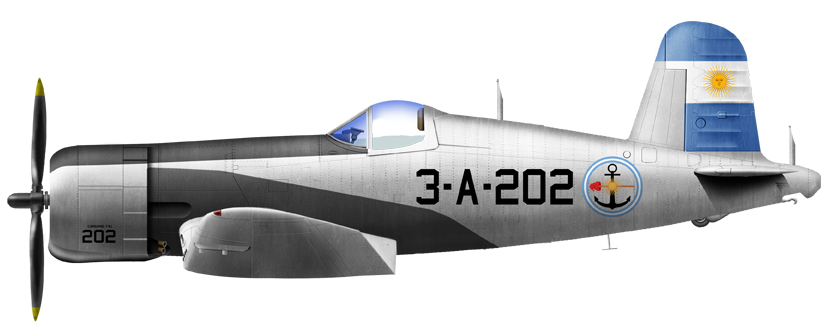
The carrier’s debut in 1958 was with a corsair-only air group. The F4U was incorporated in August 1956 and trained for its qualification aboard ARA Independencia from bases on the continent. 26 F4U-5 (12 on board) fighter-bombers, and the remainder being F4U-5N night fighters and F4U-5NL all-round fighter-bombers entered carrier service. They were for some time equipped with the airborne AN/APS-4 radar and remained in service for about 10 years.
The first twelve F4U-5 acquired were stored in poor general condition before transfer by Aero Corp. of Georgia, Atlanta, with new stock engines. One crashed before delivery on 5/19/1957. The most precious soon became the modernized F4U-5N/NL which in addition to the AN/APS radar had an autopilot and an engine flame extinguisher, being night-capable. In May 1957 five more were acquired as replacements due to accidents, and three for spares. The 2nd Attack Squadron had a night operations (F4U-5N/NL) group and the other for day operations (F4U-5). They started operations on the carrier by mid-1959 and took part in several multinational exercises. In 1961 they fired at a uknown submarine caught in the Nuevo Gulfo, and took part in the events of 1963, and by 1965 were deployed after the border incident with Chile in the far south. The last were seen during an air parade in Ushuaia on July 9, 1965. The squadron was disbanded in 1966, the last being decommissioned in November 1965.
Argentinian AT-6 Texan/ NA SNJ-4
The Argentine Navy acquired a total of 94 (AT-6/BC-1/SNJ-3/-4) and 30 (SNJ-5), some later used for spare parts. On the carrier, these were used for training of coursen but also for coastal patrol, liaison and light attack, with the SNJ-5C modified in 1959 for carrier used and adopted, remaining in service until replaced in 1967 by the North American T-28.
On ARA Independencia, after the first naval landing carried out by Lieutenant Commander Martinez Achaval on June 8, 1959 they constituted the 3rd Aeronaval Attack Squadron
They took part to attack missions in 1963 against army units during an insurrection. They basically followed the retirement of the Vought F-4U in 1966 and for a time she only operated the SNJ, Tracker and S-55 helicopter with full replacement by a squadron of T-28, far better in performances due to their turboprop.
Argentinian F9F Panther
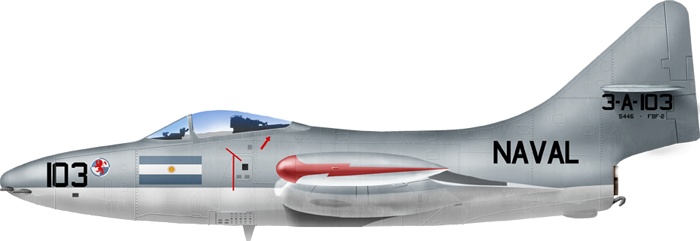
Argentinian F9F-2 Panther
In 1959 when entering service the F4U was already aging fast, even in its modernized version, so even before its introduction at the end of 1957, the Naval Aviation Command acquired 28 ex-US Navy Panther F9F-2B as early replacement for the F-4U Corsair. The first ten arrived on ARA B-6 Bahía Buen Suceso by August 1958. and more purchased for spare parts. They were re-painted with new pennants and numbers.
The firt entered service from November 1958 with the 1st Aeronaval Squadron (2nd Aeronaval Squadron), and later registration was changed from 2-A-20 to 2-A-101, transferred to the 3rd Naval Air Squadron in Punta Indio, but they did not serve on board ARA Independencia due to the catapult lacking power for this, and only from ground bases. As for the F9F-8T Cougar, same picture, they never served aboard. In 1966 indeed, Independencia only had Trackers, Trojans and helicopters as shown in all photos. Venteicinco de Mayo however would operate instead the A-4Q Skyhawk and super etendard. But she had reinforced decks and a better catapult.

⚙ specifications |
|
| Displacement | 19 000 t |
| Dimensions | 221,67 x 27,40/24,40 x 7,30 m ( x x feets) |
| Propulsion | 2 steam turbines Parson, 4 Admiralty Boilers, 42,000 HP |
| Speed | 25 knots |
| Range | 12,000 mn @14 kts |
| Armament | 5 twin Bofors 40mm/60 AA mounts |
| Protection | Same as Warrior |
| Crew | 1,175 to 1,300 |
ARA Independencia’s career
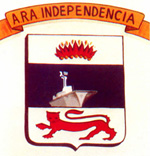 After a study of the strategic maritime situation of Argentina carried out in 1942, analyzing probable theaters of operations, the need to have two aircraft carriers was proposed by the naval staff, procured through decree N. º 9006/43 of September 16, 1943 as purchase authorization. However the international situation would delay that acquisition for 13 years…
After a study of the strategic maritime situation of Argentina carried out in 1942, analyzing probable theaters of operations, the need to have two aircraft carriers was proposed by the naval staff, procured through decree N. º 9006/43 of September 16, 1943 as purchase authorization. However the international situation would delay that acquisition for 13 years…

By September 16, 1958 and by decree 5939/58 “S”, the purchase of an ex-British aircraft carrier, HMS Warrior, was approved. It was partly financed by the sell of former battleships and their usueful steel content: ARA Moreno and ARA Rivadavia, two former US-built dreadnought, and the very old ARA Pueyrredón, a former Garibaldi class armored cruiser.
The former HMS Warrior missed WW2 and in the postwar context mostly served with a reduced crew of 500 for 10 weeks, later reconverted to carry troops and vehicles to Korea and placed in and out of deactivation and reserve. She was as said above, modernized twice however, in 1952-53 and 1957-58 making her more desirable for a foreign purchase, which was the case.

https://www.taringa.net/+info/portaaviones-ara-independencia_13737c
Her refit completion ended by July, 8, 1959 and she was renamed ARA Independencia (V-1) as one of the most cherished national ideals. During the ceremony in Britain the it was stressed the need “reaffirm the unwavering will of Argentines to maintain and strengthen it”. On October 8, 1958 already the commission took place, with the electrician frigate lieutenant Don Valentín Álvaro Fraile having the honor of hoisting the national flag for the first time.
She set sail from Portsmouth on December 10, 1958, entering after a crossing used as shakedown cruise, Puerto Belgrano on the 30th. She was escorted all along by the newly acquired Brooklyn-class cruiser ARA General Belgrano, another WW2 surplus war veteran, and the interwar Italian built ARA Veinticinco de Mayo (C-2).

In 1960 she became the new Fleet flagship, completing crew advanced training, completing enlistment, and she was assigned the Battleship berth -where the former Rivadavia class BBs were- quite a symbol of modernization of the fleet. She started operations in 1959 with the SNJ-5 Texan aircraft onboard. Recenlty acquired F4U corsairs of three types were soon about to join her.
The Embarked Air Group was completed by F4U-5 Corsair attack planes, and the four SNJ-5 Texan training/multirole planes. Pilot qualifications were made.
In 1961, ARA Independencia visited Montevideo. In April 1962, she made her first trip to the United States, to receive six Grumman S-2A Trackers aircraft, and two Grumman F9F Cougar jets (for taxiing only, she could not launch them via her catapult) and two Sikorsky S-55 helicopters. She moored in Norfolk for the transfer and started her return trip to Argentina. She arrived on May 24, 1962, at the Puerto Belgrano Naval Base. Her new air group was reconstituted around six Grumman S-2A Trackers for anti-submarine warfare, and S-55 and S-58 helicopters, before a squadron of T-28s were acquired to replace the Texans. The helicopters were not equipped for ASW warfare and rather were used for SAR missions and liaison.
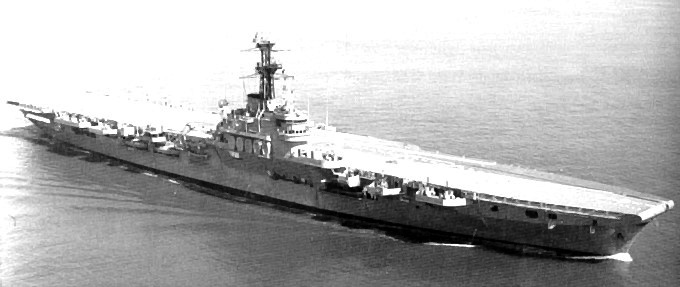
Starting in 1962, the carrier took part in all UNITAS maneuvers with the United States Navy. From 1967 she headed the Centennial Naval Review off Mar del Plata.
In 1963 an SNJ-5 Texan crashed and pilot Lt. Gustavo Lara, died. That same year, night operations for the newly acquired the S-2F Tracker started.
Although the carrier was assigned a group of F9F-2B Panther and another of F9F-8T Cougar jet fighters the weak catapult prevented their use on board. Still, they performed landings: One F9F-2B 0453/3-A-119 made an emergency landing, hooking the first braking cable on July 27, 1963 (aptain Justiniano Martínez Achaval). Independencia had to sail back to Puerto Belgrano Naval Base for having it return as it could not take off from her deck.

During her intense operational life, Independencia participated in yearly joint maneuvers with the Armada, USN, Royal Navy, Italian Marina Militare, and French Marine Nationale as well as the Uruguayan Navy across the Atlantic. She took part in many exercises with the Argentine Army, as well as the Argentine Naval Prefecture and Merchant Navy.
On S-2F Tracker, #0542/2-AS-7 (Lt. Juan Salaverri) made her 5,000th landing in November 1967 and a year later, was the last aircraft to be catapulted.
After the arrival of the ARA Veinticinco de Mayo (V-2) in 1969, Independencia went into reserve. She was offered to the Peruvian Navy, but not accepted due to her age and lack of modern amenities. Instead she was sold for scrap to a local company, starting in October 1971 in Rosario by Saric S.A. after acquisition at a public auction for m$n 222,200,000.7.
Read More
Links
amilarg.com.ar: grumman-panther in argentina
argentinian cougar
argentinian f4u corsair
argentinian sikorsky-s-55
argentinian north american texan
argentinian grumman tracker
on navypedia.org/
on zona-militar.com/
on facebook.com/
on comunidadnautica.com
on militaryfactory.com/
es.wikipedia.org ARA Independencia (V-1)
histarmar.com.ar Independencia
fdra.blogspot.com independencia
museoaeronaval ara-independencia
Aeronaves que operaron en el portaviones “Ara Independencia”
Model Kits
on modellmarine.de, scratchbuilt colossus conversion
Video

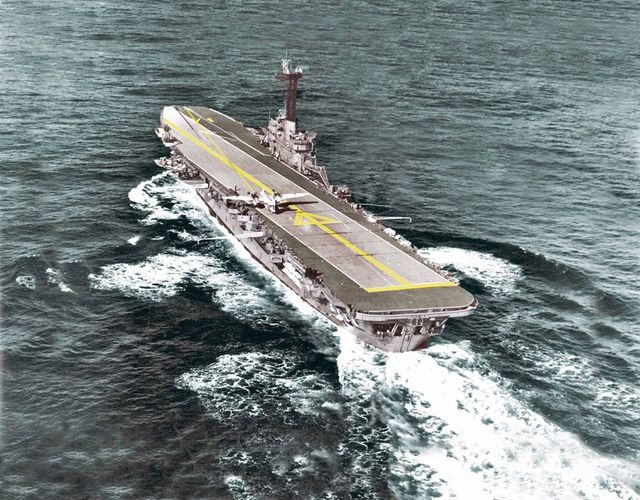
 Latest Facebook Entry -
Latest Facebook Entry -  X(Tweeter) Naval Encyclopedia's deck archive
X(Tweeter) Naval Encyclopedia's deck archive Instagram (@navalencyc)
Instagram (@navalencyc)





 French Navy
French Navy Royal Navy
Royal Navy Russian Navy
Russian Navy Armada Espanola
Armada Espanola Austrian Navy
Austrian Navy K.u.K. Kriegsmarine
K.u.K. Kriegsmarine Dansk Marine
Dansk Marine Nautiko Hellenon
Nautiko Hellenon Koninklije Marine 1870
Koninklije Marine 1870 Marinha do Brasil
Marinha do Brasil Osmanlı Donanması
Osmanlı Donanması Marina Do Peru
Marina Do Peru Marinha do Portugal
Marinha do Portugal Regia Marina 1870
Regia Marina 1870 Nihhon Kaigun 1870
Nihhon Kaigun 1870 Preußische Marine 1870
Preußische Marine 1870 Russkiy Flot 1870
Russkiy Flot 1870 Svenska marinen
Svenska marinen Søværnet
Søværnet Union Navy
Union Navy Confederate Navy
Confederate Navy Armada de Argentina
Armada de Argentina Imperial Chinese Navy
Imperial Chinese Navy Marinha do Portugal
Marinha do Portugal Mexico
Mexico Kaiserliche Marine
Kaiserliche Marine 1898 US Navy
1898 US Navy Sovietskiy Flot
Sovietskiy Flot Royal Canadian Navy
Royal Canadian Navy Royal Australian Navy
Royal Australian Navy RNZN Fleet
RNZN Fleet Chinese Navy 1937
Chinese Navy 1937 Kriegsmarine
Kriegsmarine Chilean Navy
Chilean Navy Danish Navy
Danish Navy Finnish Navy
Finnish Navy Hellenic Navy
Hellenic Navy Polish Navy
Polish Navy Romanian Navy
Romanian Navy Turkish Navy
Turkish Navy Royal Yugoslav Navy
Royal Yugoslav Navy Royal Thai Navy
Royal Thai Navy Minor Navies
Minor Navies Albania
Albania Austria
Austria Belgium
Belgium Columbia
Columbia Costa Rica
Costa Rica Cuba
Cuba Czechoslovakia
Czechoslovakia Dominican Republic
Dominican Republic Haiti
Haiti Hungary
Hungary Honduras
Honduras Estonia
Estonia Iceland
Iceland Eire
Eire Equador
Equador Iran
Iran Iraq
Iraq Latvia
Latvia Liberia
Liberia Lithuania
Lithuania Mandchukuo
Mandchukuo Morocco
Morocco Nicaragua
Nicaragua Persia
Persia San Salvador
San Salvador Sarawak
Sarawak Uruguay
Uruguay Venezuela
Venezuela Zanzibar
Zanzibar Warsaw Pact Navies
Warsaw Pact Navies Bulgaria
Bulgaria Hungary
Hungary

 Bundesmarine
Bundesmarine Dutch Navy
Dutch Navy Hellenic Navy
Hellenic Navy Marina Militare
Marina Militare Yugoslav Navy
Yugoslav Navy Chinese Navy
Chinese Navy Indian Navy
Indian Navy Indonesian Navy
Indonesian Navy JMSDF
JMSDF North Korean Navy
North Korean Navy Pakistani Navy
Pakistani Navy Philippines Navy
Philippines Navy ROKN
ROKN Rep. of Singapore Navy
Rep. of Singapore Navy Taiwanese Navy
Taiwanese Navy IDF Navy
IDF Navy Saudi Navy
Saudi Navy Royal New Zealand Navy
Royal New Zealand Navy Egyptian Navy
Egyptian Navy South African Navy
South African Navy






























 Ukrainian Navy
Ukrainian Navy dbodesign
dbodesign